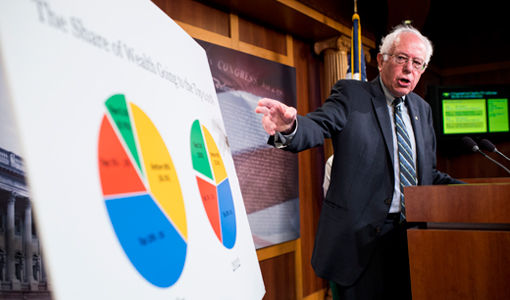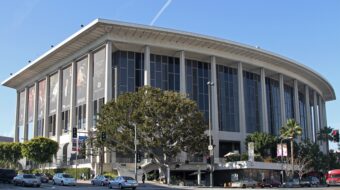
With the race for the Democratic nomination now in full swing and the two main candidates trading jabs over who has the most progressive credentials, a major left economist has just completed an analysis of what the budget might look like under a President Sanders and gives it the thumbs up when it comes to jobs, growth, and equality.
People’s World obtained a copy of the new report which is just being released titled, “What would Sanders do? Estimating the impact of Sanders programs.” It is the work of economics professor Gerald Friedman and compiles two dozen of the major proposals released by the Sanders campaign. By treating the platform as a whole, the report gives the first look at the real potential economic impact of a Sanders Administration. It is the first complete overview of what could be expected if the Sanders plan was implemented in full.
“Like the New Deal of the 1930s,” Friedman says, “Sanders’ program is designed to do more than increase economic activity: the expenditure, regulatory, and tax programs will increase economic activity and employment and promote a more just prosperity, a ‘broadly-based’ prosperity with a narrowing of economic inequality.”
Friedman is a professor in the economics department at the University of Massachusetts at Amherst, and has recently faced off with the Wall Street Journal over that newspaper’s disingenuous claims about Sanders’s spending proposals. He has been a prominent voice in defense of the economic credentials of the Medicare for All proposal and has a distinguished scholarly record in the field of political economy and the economic history of trade unionism.
The report analyzes more than twenty distinct planks found in the Sanders platform and evaluates their economic impact in the style of a Congressional Budget Office (CBO) or Office of Management and Budget (OMB) review. It looks at what the outcomes would be if the country followed current status quo assumptions about growth and economic development and then compares them with what could be expected by the end of a two-term Sanders presidency in 2025.
Investments in the future
With an ambitious $14.5 trillion dollars of investments, the agenda set out by Sanders is fully paid for with more than $16 trillion dollars of anticipated revenues. Through a combination of a 1 percent wealth tax on fortunes valued at more than $21 million, a financial transactions tax, lifting the cap on the Social Security payroll tax and extending it to dividend and capital gains income, a 4.75 percent employer payroll tax, as well as a host of other measures, Sanders’ plan would not only boost growth but also eliminate the budget deficit.
Among the big ticket spending items are a $1 trillion infrastructure plan – the Rebuild America Act – a $750 billion College for All program, an across-the-board Social Security increase totalling almost half a trillion, and Medicare for All – a $10 trillion rollout of healthcare for every American.
Putting paid to GOP claims that only tax cuts for the wealthy can deliver growth, Friedman demonstrates that Sanders’ massive public investments would act as a giant stimulus on the economy. Government output is predicted to spur businesses to hire and encourage workers to spend more, thus generating the need for even more hires – sparking a virtuous circle of growth.
Faster growth, more jobs, and higher wages
On the economic growth and jobs front, Friedman foresees “a dramatic acceleration in economic growth and employment,” raising wages for the lowest-paid workers and narrowing the gap between the rich and poor. He estimates that Sanders’ program, if implemented in full, would generate 34 percent in additional real GDP nationally. For working families, this means that median household income would go from $59,336 to $82,151 – a 38 percent Sanders dividend.
By 2026, the expected unemployment rate would be 4.0 percent, rather than the currently forecast 5.4%. With more than 23 million new jobs, in economic terms this means that full employment would be reached by the end of Sanders’ second term.
It represents more than a doubling in real per capita income. Not only will more Americans be working, they will also be making more money.
Shrinking the gap between rich and poor
The CBO currently predicts a future poverty rate of 13.9 per cent under prevailing economic conditions, but if the Sanders program was enacted, this would drop to below 7 per cent.
Boosting incomes for working Americans while increasing taxes on the top ranks of the wealthy will act to shrink the gap between the richest and poorest. A 2.2 per cent income-based premium will be levied on households, with the funds generated going toward Medicare for All.
Minimum wage boosts, regulatory changes to make unionization easier, and savings from healthcare costs are forecast to almost triple wage growth from the current rate of 10 per cent to 29 per cent. For the lowest earners, this will mean an income boost of 24 per cent.
While inequality would still be a significant problem even if all of the Sanders program were implemented, there would finally be a reversal of the trend that has seen the gap between rich and poor grow ever-wider for more than forty years. Through a combination of regulatory efforts and more progressive tax increases, the ratio between the top and bottom would return to 1970s levels.
Real fiscal responsibility
One real coup that the Sanders program would pull off is a return of the federal budget to fiscal balance. Though no one can accuse of him of being a fiscal hawk, Sanders would actually return the federal government to a surplus by his second term. This would come about as a consequence of the projected revenue increases from both progressive taxation and more rapid economic growth, as well as lower social spending costs on budget items like unemployment insurance.
By 2026, the deficit would be eliminated and a budget surplus of up to 3 per cent of GDP would be achieved. In such a turn of events, the accusation made by the GOP and right-wing Democrats for decades that we can’t afford to have both a robust public welfare state and a strong economy would be dramatically dispelled.
The last time the budget was balanced was in 1998, a result of a compromise between President Bill Clinton and the Republican-controlled Congress. The Sanders plan achieves balance without any cuts or fiscal austerity.
Class struggle and political reality
Such a powerful study of course also has to be matched with a heavy dose of political realism. First of all, productivity gains will outpace wage gains, which in terms of critical political economy means the rate of exploitation of labor will go up. Workers will make more, but they will be producing even more profits for employers as well.
That is why it is at least plausible to think even some sections of capital could someday be persuaded by the Sanders campaign. Not likely, but plausible. They will pay more in taxes, but they will also have the possibility of increasing their profit margins.
Most wage growth and poverty reductions in the Sanders program are the product of government action, not collective bargaining. This is one aspect that makes it different from the New Deal and post-war period. As such, rapid inflation is not forecast to be a major concern as it was in the 1960s and 70s. While there are plans for making it easier for labor to organize, there is no expectation that the labor movement as a whole will grow dramatically or become significantly stronger.
This means there will be no serious wage pressure. Thus, the move toward a balanced budget in combination with a still-weak labor movement should remove the incentive for the Federal Reserve to raise interest rates. It’s no guarantee though.
That’s the technical side of things. The other aspect to consider is that, for the purposes of fully analyzing the potential impact of the Sanders plan, the assumption is made that every piece of the campaign platform would be implemented in full. With GOP and right-wing Democrats opposing a would-be President Sanders every step of the way, such an assumption is more than a just a little uncertain. It is, in fact, a political impossibility.
As Friedman makes clear, “The Sanders program would, of course, face political obstacles to enactment.” Economic obstacles could also abound “if the Federal Reserve moves aggressively to abort the [Sanders] economic expansion by reducing monetary growth and raising interest rates.” There’s also the possibility of a strike by capital in which raising wages leads businesses to refuse new investment or to make further hires.
These are all the perils of attempting to implement an alternative to the current finance-dominated system of casino capitalism. In the words of Friedman, “In the end, success or failure rests on the strength of the political forces behind a Sanders Administration.” Acknowledging the hurdles doesn’t mean it isn’t worth a try though.
Photo: Senate Budget ranking member Bernie Sanders, I-Vt., holds a news conference to introduce legislation “to make millionaires and billionaires pay their fair share of estate taxes and close loopholes that have allowed billionaires to avoid billions in taxes” on Thursday, June 25, 2015. Bill Clark | CQ Roll Call via AP Images












Comments